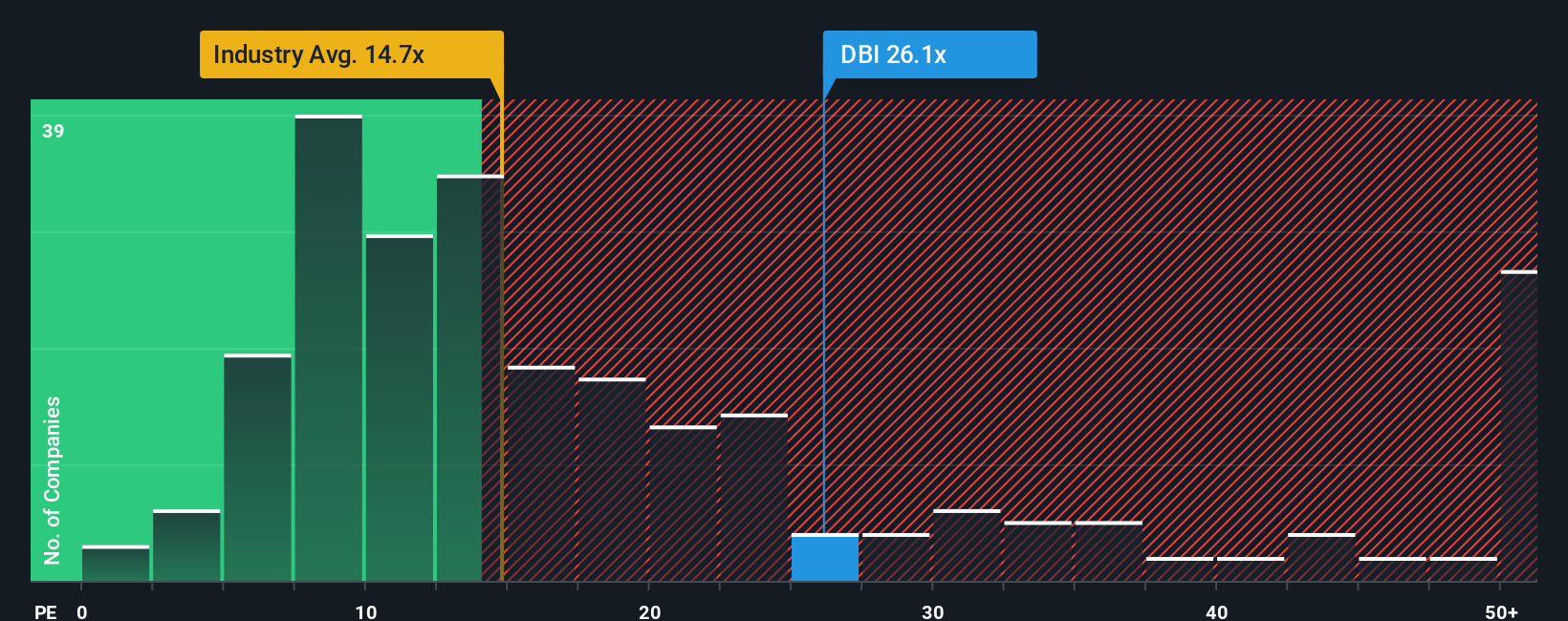- Australia
- /
- Infrastructure
- /
- ASX:DBI
Dalrymple Bay Infrastructure Limited's (ASX:DBI) Share Price Could Signal Some Risk
Dalrymple Bay Infrastructure Limited's (ASX:DBI) price-to-earnings (or "P/E") ratio of 26.1x might make it look like a sell right now compared to the market in Australia, where around half of the companies have P/E ratios below 19x and even P/E's below 11x are quite common. However, the P/E might be high for a reason and it requires further investigation to determine if it's justified.
Dalrymple Bay Infrastructure certainly has been doing a good job lately as it's been growing earnings more than most other companies. It seems that many are expecting the strong earnings performance to persist, which has raised the P/E. If not, then existing shareholders might be a little nervous about the viability of the share price.
Check out our latest analysis for Dalrymple Bay Infrastructure

How Is Dalrymple Bay Infrastructure's Growth Trending?
In order to justify its P/E ratio, Dalrymple Bay Infrastructure would need to produce impressive growth in excess of the market.
Retrospectively, the last year delivered an exceptional 16% gain to the company's bottom line. The strong recent performance means it was also able to grow EPS by 361% in total over the last three years. Accordingly, shareholders would have probably welcomed those medium-term rates of earnings growth.
Turning to the outlook, the next three years should generate growth of 4.7% per year as estimated by the five analysts watching the company. That's shaping up to be materially lower than the 15% each year growth forecast for the broader market.
With this information, we find it concerning that Dalrymple Bay Infrastructure is trading at a P/E higher than the market. Apparently many investors in the company are way more bullish than analysts indicate and aren't willing to let go of their stock at any price. Only the boldest would assume these prices are sustainable as this level of earnings growth is likely to weigh heavily on the share price eventually.
The Key Takeaway
We'd say the price-to-earnings ratio's power isn't primarily as a valuation instrument but rather to gauge current investor sentiment and future expectations.
We've established that Dalrymple Bay Infrastructure currently trades on a much higher than expected P/E since its forecast growth is lower than the wider market. When we see a weak earnings outlook with slower than market growth, we suspect the share price is at risk of declining, sending the high P/E lower. Unless these conditions improve markedly, it's very challenging to accept these prices as being reasonable.
You should always think about risks. Case in point, we've spotted 2 warning signs for Dalrymple Bay Infrastructure you should be aware of.
If P/E ratios interest you, you may wish to see this free collection of other companies with strong earnings growth and low P/E ratios.
New: Manage All Your Stock Portfolios in One Place
We've created the ultimate portfolio companion for stock investors, and it's free.
• Connect an unlimited number of Portfolios and see your total in one currency
• Be alerted to new Warning Signs or Risks via email or mobile
• Track the Fair Value of your stocks
Have feedback on this article? Concerned about the content? Get in touch with us directly. Alternatively, email editorial-team (at) simplywallst.com.
This article by Simply Wall St is general in nature. We provide commentary based on historical data and analyst forecasts only using an unbiased methodology and our articles are not intended to be financial advice. It does not constitute a recommendation to buy or sell any stock, and does not take account of your objectives, or your financial situation. We aim to bring you long-term focused analysis driven by fundamental data. Note that our analysis may not factor in the latest price-sensitive company announcements or qualitative material. Simply Wall St has no position in any stocks mentioned.
About ASX:DBI
Dalrymple Bay Infrastructure
Owns the lease of and right to operate the Dalrymple Bay terminal, a metallurgical coal export facility in Bowen Basin in Queensland, Australia.
Proven track record with imperfect balance sheet.
Market Insights
Community Narratives




